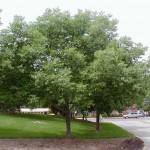Run for your lives! Save the women and children first. Hide the ash trees!…..Wait, what?!?! You heard me. Hide the ash trees, cloak them, disguise them as something else or find a futuristic bio dome to put them under. What is going on here??? The Borers are coming. Yup, the Ash trees are slowly being killed off by the Emerald Ash borer. It is working its way across North America by propagation and transportation of infected firewood. So hide your Ash! This isn’t really possible, but let’s consider why we are in this predicament and how we can prevent similar events from occurring in our future.
You see, each tree found in your landscape was planted with a specific purpose behind it whether you realize it or not. Ash trees were planted as trees that were adaptable to different soil conditions, climates, and made good shade trees in various environments. They could withstand some of the pollutants common in the cities and performed well in adversity. Ash became a staple in many home landscapes, but as with viruses we people deal with every winter, diseases and pests also adapt to different environments and circumstances. No more Ash trees, Cut them down and burn them up! Hold your horses there. There are some things you need to understand. The flu vaccine you received 3 years ago is a different strain than the one you received this year, because the virus changed which made the vaccine less affective. It’s an inevitable chain of events. No one tree variety is any more perfect than we are. Each has weaknesses, some we know about and some we don’t until a disease or pest infiltrates the tree. The Emerald ash borer was first found in North America in 2002 and has since killed off hundreds, if not thousands of ash trees in the eastern and central states. Most of the Elm trees in the United States are also suffering from a disease which causes the tree to cut itself off from nutrients and eventually kill itself. Silver maples succumb to high winds and have overall weak wood, but were planted everywhere due to their quick, large growth patterns. So what in the world are we supposed to plant then with all these hazards! Well, you will be glad to know that horticulture nerds are hard at work to produce trees that are more resistant to their predecessor’s weaknesses. In the meantime, and hopefully from now on we learn to love diversity. Often a tree becomes popular due to its strengths, and like a video that goes viral, gets over used. When the weaknesses come to the forefront that tree gets hit hard and great loss follows. If instead we wisely choose several kinds of trees to group within a landscape or area, loss is minimized when the weakness finally presents itself or becomes a threat. This doesn’t mean don’t plant the next great tree (ie. Red pointe Maple, River birch or Japanese maple), but it does mean that both consumers and the landscaping industry as a whole should diversify their plantings. In turn we will gain a stronger, longer future for our environment and the investments we make in it every day!
- Identification characteristics
- Actual size of adult borer
- White ash












